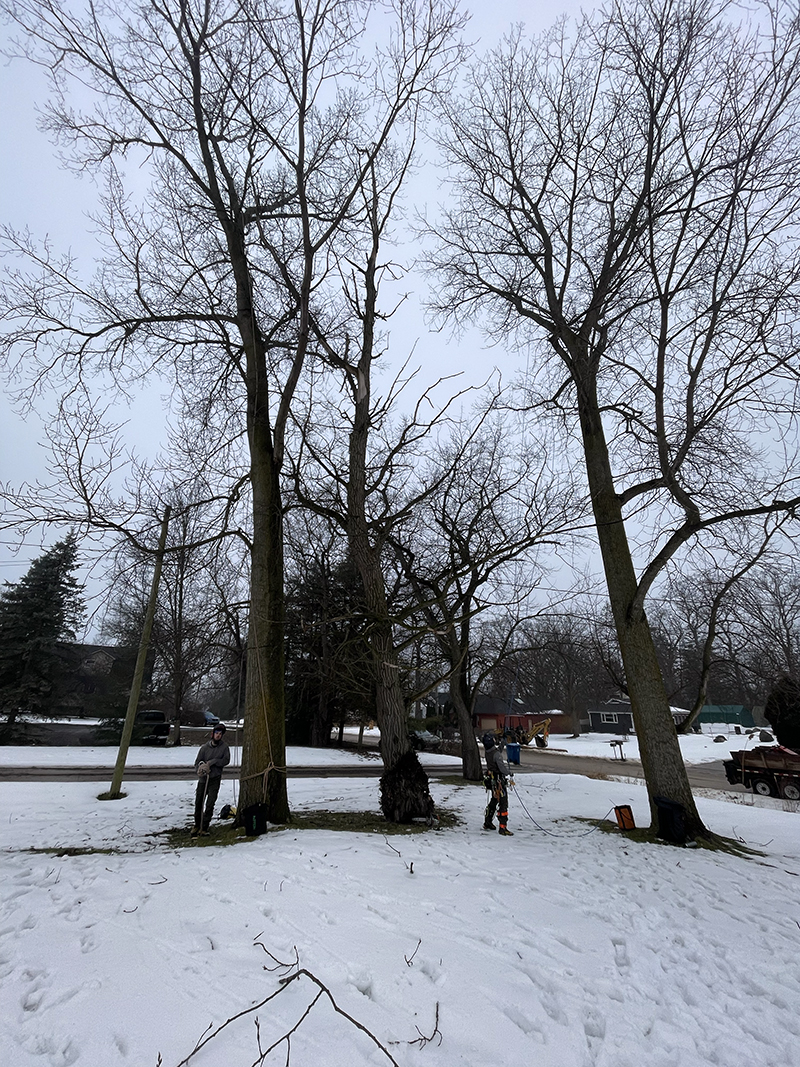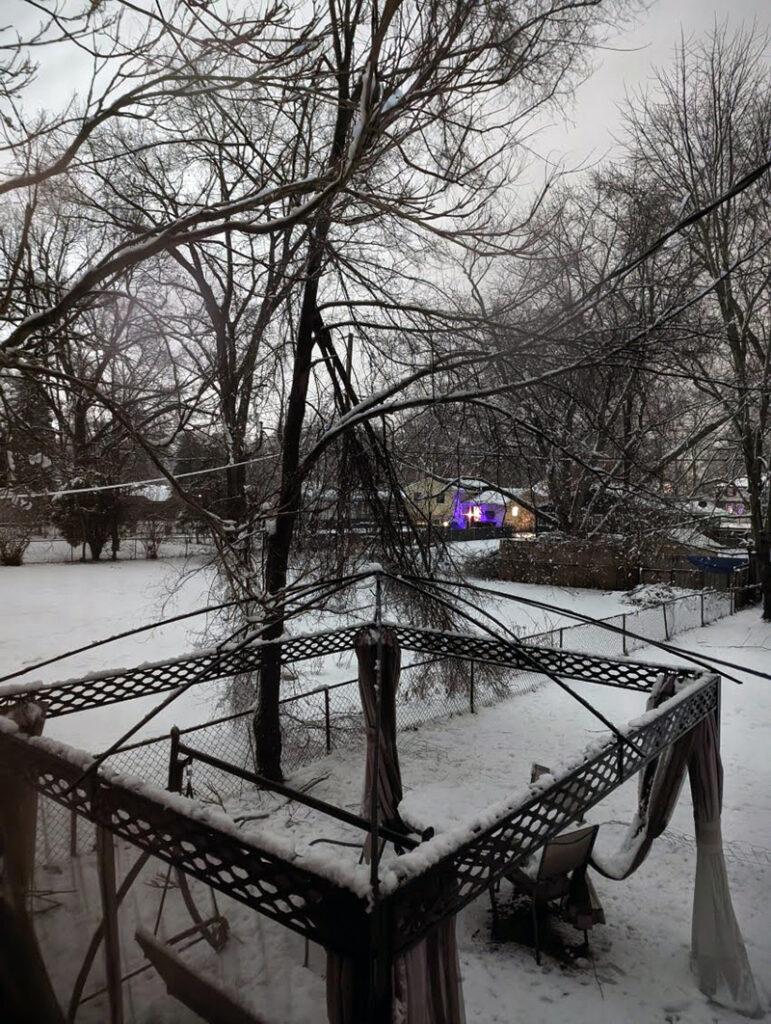Michigan’s winter trees may look charming with their white-tipped branches and pronounced branch structures. But with the challenges of freezing temperatures paired with intense winter storms, your prized trees are also in danger of being damaged.
When heavy snow, freezing rains, and chilling high winds come together, even the sturdiest of oaks and maples will struggle against the onslaught.
During these moments, the property owner’s knowledge and preparedness in responding to winter storms can make all the difference in saving their trees.

How Snow and Ice Storms Cause Tree Damage
Unlike your typical rainstorm, a winter storm doesn’t just put pressure on your trees by blowing winds and rain.
The weight of snow and ice also adds a lot more stress to your tree’s branches.
This amount of stress can cause these branches, including major limbs, to break.
In worst cases, it will split the trunk or even uproot the entire tree.
Certain trees are especially vulnerable to these storms:
- Young trees that are not yet fully established.
- Dead, diseased, and decaying trees.
- Evergreen trees with branches that hold on to snowfall.
- Trees that are neglected and have weakened.
- Tree species with soft wood, such as silver maples, birches, cottonwood, and willows.
In late March 2025, a historic ice storm caused significant snow damage to millions of trees across Northern Michigan’s forests, underscoring the severe threat that massive ice storms can pose.
After the Storm: What to Watch Out For
After the winter storm has settled outside, prioritize safety as you inspect your surroundings.
Consider damaged trees as active potential hazards even after the storm has passed.
- Broken Branches. Precariously hanging branches can fall and cause injuries or property damage.
- Leaning or Falling Trees. Whether a tree is about to fall or has already fallen, it poses safety risks to its surroundings and causes inconveniences like blocked roads.
- Broken Power Lines. Fallen trees or tree limbs can also damage power lines, resulting in electrical and fire hazards, as well as power outages.
- Storm Debris. Other woody debris can remain at the tree’s canopy and fall at any time after the storm has passed.
- Root Injury. Visible root injuries indicate that the tree’s structure has weakened, potentially risking uprooting.
When significant risks have been confirmed, seek professional assistance to restore your yard’s safety.
For your safety, do not touch your tree if it is in contact with broken power lines.
Contact the utility company immediately to have the lines repaired.
To address concerns such as fallen, leaning, and damaged trees, call your local tree care company.
An expert arborist can help you remove the debris and trees that are beyond saving, while helping your other trees recover from the damage.
What to Avoid After a Winter Storm
After the storm, you may want to start working on your yard as soon as possible, but the truth is that rushing it may do more harm than good.
- Stay at a reasonable distance from damaged trees, as snow and ice may conceal injuries that can cause large limbs to break.
- Do not touch trees that have been entangled with power lines, as electricity can course through ice, snow, and wet wood.
- Do not try to remove large tree limbs by yourself. It’s best to call experienced and well-equipped professionals.
- Do not “top” your trees, as this weakens the overall structure. Selective pruning can preserve the tree’s natural shape without compromising its health.
- Untrained pruning can result in long-term damage to a tree.
Having expert arborists to help you with your tree needs will give you the peace of mind that your tree’s long-term health is the main goal in every decision.
Tree Services for Post-Storm Scenarios
If your trees have incurred significant damage, hiring professionals ensures that your landscape will be restored appropriately and your trees will receive efficient support for their recovery.
Tree Risk Assessment
Not all tree damage may be instantly visible.
A tree risk assessment involves a TRAQ (Tree Risk Assessment Qualification) qualified arborist who will thoroughly evaluate the hazards that are present in your tree.
These hazards include hanging limbs, leaning trees, branches that poke at power lines, and significant cracks on tree trunks that may compromise its structure.
Based on this tree assessment, your arborist will provide recommendations to restore the safety and beauty of your outdoor space, as well as solutions to support the rehabilitation of the affected trees.

Storm Cleanup
Tree care professionals can clean up any fallen tree branches, uprooted trees, and other debris left by the winter storm.
As experts in these types of services, they possess the proper tools and experience to complete the job safely, swiftly, and efficiently.
Tree Pruning
When pruning a tree that received ice storm damage, the goal is to remove dangerous branches and help it heal without further complications.
Cleaning up the cuts where the branches split will ensure that the wounds close naturally, so when spring arrives, your tree won’t be wide open to diseases and pests.
Tree Removal
Unfortunately, not all trees can survive severe ice damage.
Upon professional assessment, an arborist will inform you whether your trees can be saved or if their weakened structure is too much of a risk to your yard.
Stump Grinding
If your tree split and fell, the remaining stump should also be removed.
It’s not just a trip hazard and an eyesore, but the remaining roots will continue to spread and may cause damage to the soil or compete with the surrounding trees and shrubs for nutrients.
Emergency Tree Care Services
If your situation poses a risk to public safety and requires immediate action, you can rely on tree companies that offer emergency services.
Ascension Tree Care is available 24/7 for emergencies, with quick response times to reduce damage and restore the safety of your Michigan property.
Getting Your Trees Back on Track
After the winter storm, your damaged trees will also need long-term solutions to help them bounce back:
- Structural Support. If your trees have lost their major limbs or are structurally unsound, cabling and bracing can stabilize them as they regain their strength.
- Root Zone Care. Winter storms can compromise soil health, which can be revitalized with soil aeration and deep root fertilization.
- Monitoring and Maintenance. Keep a close eye on your trees and watch for signs of delayed stress, addressing them promptly.
- Plan for the Future. Moving forward, maintain a schedule for regular tree inspections and maintenance to ensure your tree remains healthy and can withstand winter storms.

What to Do Before a Winter Storm
Prevention is crucial if you really want to protect your trees from the extreme weather events that Michigan winters bring.
Here are ways to prepare them for these winter storms:
- Wrap young and mature trees with burlap wrap to reduce stress when snow and ice accumulate on your branches. This also prevents your tree from having sunscald.
- You can create a small tent with sticks and frost cloth to protect small trees.
- Consult an ISA-certified arborist who can assess your tree’s condition and recommend ways to support it come the cold winter.
- Regular tree maintenance, such as trimming and pruning, helps stabilize the tree’s structure and promote its overall health. If necessary, thinning the crown may also help alleviate the effects of intense wind pressure.
Ascend Your Tree’s Winter Protection
Considering the state’s severe winter storms, tree owners in Michigan must know how to handle storm-damaged trees after ice or snowfall.
However, you don’t have to deal with these challenges alone.
Ascension Tree Care is your trusted tree care company in Michigan.
Based in Milford, our team of ISA-certified arborists is equipped with extensive arboricultural expertise, years of experience, and state-of-the-art equipment to bring Michiganians efficient tree solutions.
